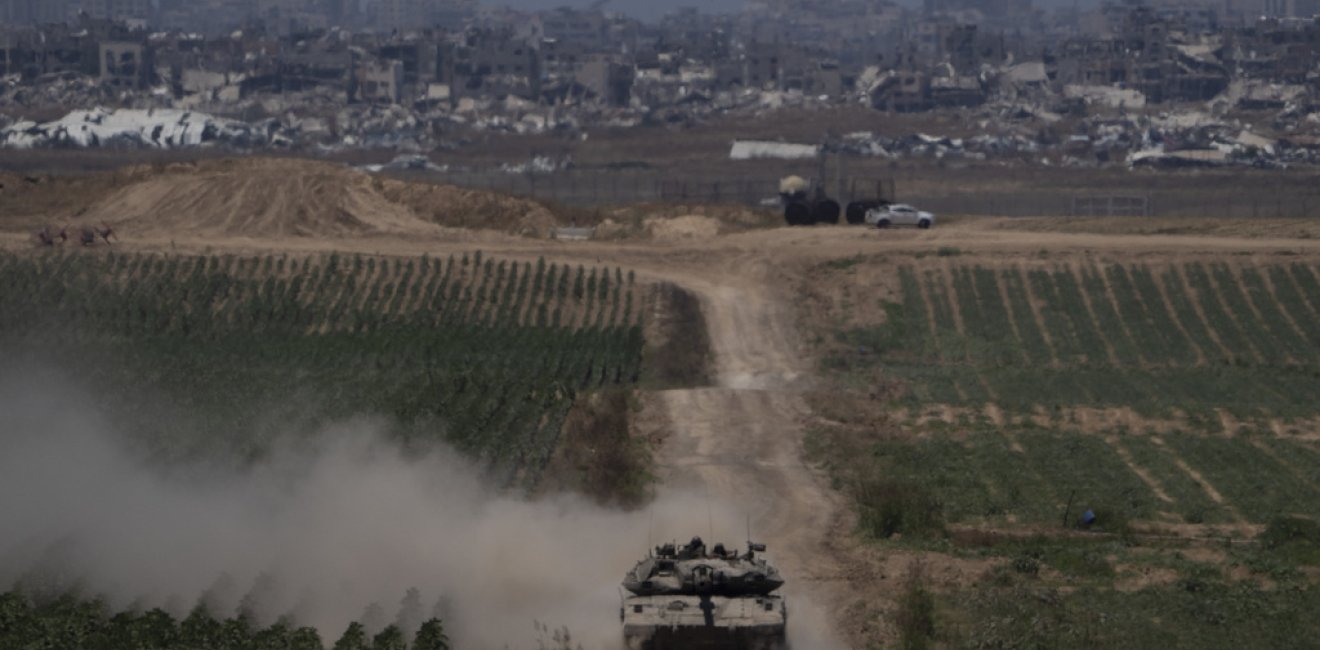Despite Hamas’ initial rejection of the recent Israeli three-phase ceasefire proposal announced by President Joe Biden on May 31 and the continuing confusion about Israeli Prime Minister Netanyahu’s position on his own government’s proposal, the proposal represents an extraordinary step forward in the horrific Gaza conflict. The US, as Secretary Blinken reiterated to Israeli Defense Minister Gallant on June 24, is still pursuing a deal within its framework. Washington should press even harder on this effort, pushing all sides to accept the ceasefire proposal and commit to a major effort in Gaza if a cessation of hostilities is achieved.
The Israeli proposal, for the first time, lays out a war-ending scenario, a “cessation of hostilities permanently,” including complete Israeli military withdrawal from Gaza and return of all living hostages. Such a shift makes sense, as the current military situation argues for a ceasefire, with both sides facing diminishing gains from further fighting. Hamas risks an eventual loss of its top leaders and even more of its trained cadre. Israel, having achieved at least the temporary dismantlement of Hamas’ conventional offensive capability, is under growing pressure to wind down from both hostage families and international actors beginning with Washington, and faces serious risks in tying troops down in Gaza while Hezbollah threatens from the north.
If an international presence can take over the governance of Gaza and assume Israel’s blockade of the Egyptian-Gaza border, Israel may find the outcome sufficient to meet its minimum war goals.
Thus, given the battering Hamas has suffered, it might be compelled to abandon its political control of Gaza and possibly exile of its leaders, in return for survival as an underground movement. If an international presence can take over the governance of Gaza and assume Israel’s blockade of the Egyptian-Gaza border, Israel may find the outcome sufficient to meet its minimum war goals.
The new terms
It is important to note that the offer of total withdrawal and permanent cessation of hostilities represents a new formal Israeli position, where previously Israeli intentions were obscure, and, as President Biden noted, some in Israel were demanding a seemingly permanent military presence in Gaza. Equally important, the proposal establishes between Israel and, indirectly, Hamas, a process to determine the status of Gaza post-withdrawal and, most importantly, the fate of Hamas itself. However, the path to such a cessation of hostilities is more complex than President Biden indicated in his May remarks.
This Israeli proposal for indirect negotiations with Hamas on the conditions for a cessation of hostilities has both parties putting on the table their key aces in the hole—the hostages and the Israeli military presence in Gaza.
This Israeli proposal for indirect negotiations with Hamas on the conditions for a cessation of hostilities has both parties putting on the table their key aces in the hole—the hostages and the Israeli military presence in Gaza. Those negotiations would occur, if Hamas accepts the proposal, during an initial six-week ceasefire, which would include a partial exchange of hostages and Palestinian prisoners, withdrawal of Israeli troops from populated areas, and an assistance surge to the Gazan population. If, and only if, Hamas and Israel reach an agreement during those negotiations, then a second six-week phase would commence, with Israel completing its withdrawal from Gaza, all living hostages released in return for a larger Palestinian prisoner release, and some understanding or agreement on other conditions approved by the parties, culminating in the permanent cessation.
It is this Israeli focus on those “other conditions” that explains the apparent contradiction between President Biden’s description of the proposal and Prime Minister Netanyahu’s comment that nothing in the proposal contradicted Israel’s war goal of destroying Hamas. Despite that rhetoric, Israelis usually define “destroy” in more sober and feasible terms, such as removing Hamas from power and dismantling its offensive military capabilities. Such a definition closely tracks the US position, most recently described by President Biden on May 31: “a better day after in Gaza without Hamas in power,” and reinforced by National Security Advisor Jake Sullivan on June 10.
Hamas at least understands what is at stake, and thus, from media reporting and administration comments, has made a counteroffer that would move the steps automatically, with Israel agreeing in advance to withdraw all forces by a certain date regardless of the outcome of negotiations. That, of course, is unacceptable to Israel, as it would lose its primary leverage to push Hamas to compromise on Gaza the “day after.” However, this gap does not mean the proposal is dead, only that the parties are in the opening round of a typical diplomatic ‘negotiation to agree on a negotiation.’
However, the question is what arrangements could meet Israel’s minimum “other conditions.” One answer would be the permanent dismantlement of Hamas as an offensive military force, and its removal from the governance of Gaza, but not demanding that Hamas surrender, something which it almost certainly would not do. The Israelis themselves are not revealing their position here partly because their government may not have fully cleared it. President Biden, in searching for minimum conditions, noted correctly that Israel has eliminated, at least temporarily, Hamas’ ability to launch a new October 7. But Israel’s security depends also on Hamas not regenerating that capability, which next time could be deployed against Israel in conjunction with multifront attacks by Hezbollah, Iran, and other Iranian proxies. It is this nightmare that will drive Israel’s negotiations, along with the reality that Israel can no more eliminate Hamas and its personnel from Gaza than it has in the West Bank.
Permanent cessation
The most important arrangement would be a permanent cessation of hostilities and thus a renunciation of violence by Hamas (and the other major terrorist groups), not just against Israel but also against the people of Gaza and whoever comes in to help “stabilize and reconstruct” Gaza, as Sullivan recently proposed. However, this leads to the concern that, given Hamas' history of breaking ceasefires, it's unclear who would enforce any commitments they make. President Biden cited Egypt and Qatar, but neither has any particular credibility with Israel. President Biden also stated that, in case of a ceasefire violation, Israel could restart the campaign. If he is serious, that position strengthens Israel’s hand significantly, as Hamas has long counted on international, especially American, pressure to constrain Israel.
Such a permanent cessation of hostilities would not mean that Hamas surrenders, dissolves itself, or turns in its weapons. Hamas is almost certain to reject such steps, and forcing it to do so would require a military campaign similar to the allies’ six-month march through Germany 1944-45, probably beyond Israel’s military capabilities and certainly contrary to its diplomatic interests. Thus, the most likely scenario, if Hamas accepted a cessation of hostilities, is a return to an underground status similar to its West Bank presence. Israel is certainly aware of this, given its decades of experience dealing with Hamas. To ensure Hamas does not again seize power in Gaza as it did violently in 2007, Israel is likely to insist not only that Hamas not turn its weapons on whoever is trying to govern Gaza but also that its top leadership leave Gaza and agree not to return, an idea Israelis floated as early as January.
The ensuing security and governance vacuum with the Israeli military gone and Hamas underground would be filled by an outside international interim presence, the Palestinian Authority, or other Gazan Palestinians, in one or another negotiated arrangement with the crucial point that Hamas does not challenge whatever is agreed. Various plans to implement this are circulating within the US and Israeli governments and elsewhere.
Israel would also need a “serious” (euphemism for US involvement) international presence at the Rafah crossing along the Egyptian-Gaza border and offshore to permanently prevent weapons smuggling. Finally, the international community, beginning with Washington, would have to commit formally, best through a UN Security Council resolution, to support diplomatically and legally both the terms of the eventual ceasefire agreement and, explicitly, Israeli military action in response to any serious Hamas violation of these terms under its UN Article 51 right of self-defense.
While this scenario offers hope for an end to the fighting and security for both Israelis and Gazans, there are obstacles to implementation. Hamas could balk at turning over governance of Gaza (although there are indications it is considering such a step) and, in particular, resist the exile of its leaders. But in return, it would see the Israeli military leave Gaza permanently, a prominent Israeli concession, which would avoid further slow dismantlement of Hamas personnel and infrastructure. Moreover, if Hamas leadership remains in Gaza, it risks Israel getting lucky with raids on those personnel. Finally, the Israeli proposal has turned the tables diplomatically; from Israel as the usual blocker, and towards Hamas for refusing the proposal. Israel can now assert that it is continuing the fighting only because the other side will not accept a negotiation that the UN Security Council has endorsed.
Deterring Iran
Iran would not be happy with such an outcome, especially as it opens the door, as both President Biden and the UN Security Council endorsed, to progress on the two-state solution and integration of Israel into the moderate Arab world. However, Iran’s options are limited; the US has effectively deterred most Iranian and proxy military action, and continued fighting in Gaza risks escalation into Lebanon and possible defeat of Hezbollah, Iran’s most important ally.
As Prime Minister Netanyahu proposed, he is well aware that the Israeli army can neither remain in Gaza indefinitely nor wipe out Hamas to the last fighter.
As Prime Minister Netanyahu himself made the ceasefire proposal, he is well aware that the Israeli army can neither remain in Gaza indefinitely nor wipe out Hamas to the last fighter. Yet, there is no guarantee that all his cabinet ministers are in the same place. Here, the US can be helpful in various ways: first by continuing its deterrence of Iran and its proxies. It can also, through regional interlocutors, push Hamas to agree to the proposal and press Israel to negotiate in good faith and, above all, not to abandon the initiative. Finally, the US should signal to everyone that it will stand by President Biden’s words in announcing the proposal and that Israel always has the option to resume fighting if Hamas violates the ceasefire terms.
The views expressed in this piece are those of the author and do not express the official position of the Wilson Center.






